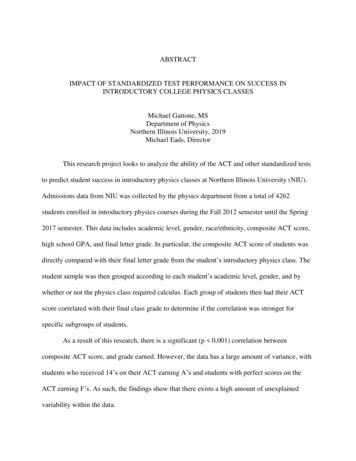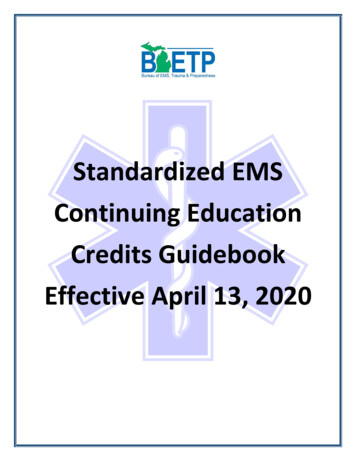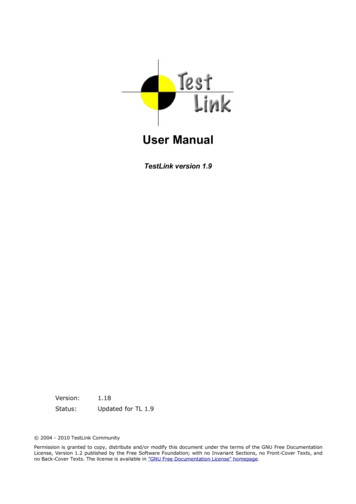
Transcription
ABSTRACTIMPACT OF STANDARDIZED TEST PERFORMANCE ON SUCCESS ININTRODUCTORY COLLEGE PHYSICS CLASSESMichael Gattone, MSDepartment of PhysicsNorthern Illinois University, 2019Michael Eads, DirectorThis research project looks to analyze the ability of the ACT and other standardized teststo predict student success in introductory physics classes at Northern Illinois University (NIU).Admissions data from NIU was collected by the physics department from a total of 4262students enrolled in introductory physics courses during the Fall 2012 semester until the Spring2017 semester. This data includes academic level, gender, race/ethnicity, composite ACT score,high school GPA, and final letter grade. In particular, the composite ACT score of students wasdirectly compared with their final letter grade from the student’s introductory physics class. Thestudent sample was then grouped according to each student’s academic level, gender, and bywhether or not the physics class required calculus. Each group of students then had their ACTscore correlated with their final class grade to determine if the correlation was stronger forspecific subgroups of students.As a result of this research, there is a significant (p 0.001) correlation betweencomposite ACT score, and grade earned. However, the data has a large amount of variance, withstudents who received 14’s on their ACT earning A’s and students with perfect scores on theACT earning F’s. As such, the findings show that there exists a high amount of unexplainedvariability within the data.
NORTHERN ILLINOIS UNIVERSITYDE KALB, ILLINOISAugust 2019IMPACT OF STANDARDIZED TEST PERFORMANCE ON SUCCESS ININTRODUCTORY COLLEGE PHYSICS CLASSESBYMichael Gattone 2019 Michael GattoneA THESIS SUBMITTED TO THE GRADUATE SCHOOLIN PARTIAL FULFILLMENT OF THE REQUIREMENTSFOR THE DEGREEMASTER OF SCIENCEDEPARTMENT OF PHYSICSThesis Director:Michael T. Eads
TABLE OF CONTENTSPageLIST OF TABLES .ivLIST OF FIGURES .vChapter1. INTRODUCTION .1Definition of Problem .2Significance of the Study .3Research Questions .3Limitation of the Study .32. LITERATURE REVIEW .5Effect on Students & Society.5Standardized Testing . .73. METHODOLOGY .9Description of Sample and Population .10Statistical Analysis .124. RESULTS .15Descriptive Statistics .15Inclusion of Calculus .18Academic Level .21Gender .25
iiiChapterPageHigh School GPA .28ACT Math Subscore .315. CONCLUSIONS AND RECOMMENDATIONS .33Summary of Findings .33Recommendations .34REFERENCES .36
ivLIST OF TABLESTablePage1. Variable Properties.92. Number of Students per Class per Semester.103. Demographic Data Sorted by Class.114. Statistical Breakdown for Each Academic Level .25
vLIST OF FIGURESFigurePage1. Histogram of Composite ACT Score.162. ACT Composite Vs Grade in Class for All Students.173. Histogram of Student Class .184. ACT Score Vs Class Grade for Non-Calculus Classes.195. ACT Score Vs Class Grade for Calculus Based Classes.206. Histogram of Student Academic Level.227. ACT Score Vs Class Grade for Freshmen.238. ACT Score Vs Class Grade for Sophomores.239. ACT Score Vs Grade for Juniors.2410. ACT Score Vs Class Grade for Seniors.2411. Histogram of Student Breakdown by Gender.2512. ACT Score Distribution for Females.2613. ACT Score Distribution for Males.2714. ACT Score Vs Grade for Females.2715. ACT Vs Class Grade for Males.2816. Histogram of Student High School GPA.2917. High School GPA Vs Class Grade.3018. Histogram of ACT Math Subscore.3119. ACT Math Subscore Vs Class Grade.32
CHAPTER 1INTRODUCTIONEvery year public school teachers and administrators face increasing pressure to havestudents meet academic performance benchmarks. Standardized tests such as the ACT and SATare primarily used to mark this achievement. As such teachers and administrators are demandinghigher test scores and high school students all across the country attempting to reach thesedemands are at dangerously high levels of stress. According to the American PsychologicalAssociation (APA), eighty-three percent of teens surveyed cited school as a source of stress,sixty-nine percent cited, “getting into a good college or deciding what to do after high school,”and sixty-five percent cited, “financial concerns for their family” (“Stress in America”, 2014).These results suggest that school and testing is the source for a large portion of today’s students’stress. Abeles highlights this sentiment, describing the emphasis on testing as out of control andcalling today’s students, “the most tested generation in history” (Abeles, 2015). Abeles arguesthat this excessive focus on testing has negative consequences, including placing unhealthy stresson students.In order to process the thousands of applicants, colleges are turning towards the ACT andSAT to rank students against each other. In order to earn admission, schools and families arepouring more of their time and money into preparing for standardized tests, such as the ACT andSAT. According to Mathew Chingos schools across America spent a cumulative 1.7 Billion on
2standardized testing (Chingos, 2012). With an investment that large, it is the aim of this study todetermine if the ACT and other standardized tests are a valid measure of performance inintroductory college physics courses.Definition of ProblemAdministrators at the high school level are pushing more and more for standardized testpreparation which is costing schools billions of dollars. Illinois spent a total of 19,011,148during the years 2007-2011 on primary assessment contracts alone, this is not including spendingon assessments not included in state’s primary assessment contracts nor does it include statelevel spending on assessment-related activities that are not contracted out (Chingos, 2012). Withschools and families spending more money on these services, it is imperative that the ACT andother standardized tests act as valid benchmarks for college readiness.For students who are looking to pursue a physics degree, the ACT is lacking in asignificant representation of physics material (“How Physics is Tested”, 2018). According totheir official ACT study guide, all the information you need to answer the questions will bepresented in the passages. “There will be no questions such as, ‘what is the second law ofthermodynamics?’, unless that answer is to be found explicitly in the given passage” (“HowPhysics is Tested”, 2018). It stands to reason then, that for these specific students, standardizedtests are especially poor indicators of potential student success. If a student wishes to go into aphysics-related major, or even take an introductory physics course, is the ACT an appropriateindicator of potential success?
3This study will compare college students’ academic performance against their ACTscores when entering college. These students’ academic achievement is defined by the grade theyearned in these introductory courses.Significance of StudyThe intent of this study is to analyze the effectiveness of standardized entrance exams forpredicting different levels of success in first year college physics courses. To gauge studentsuccess, every student enrolled in a physics class as a freshman had their final grade in the classrecorded. The five classes recorded were PHYS 273, 253, 211, 210 and 150. Over 4000 studentgrades were recorded and referenced to their ACT scores that they reported to NIUadministration.Research QuestionsI. Does ACT score correlate with performance in introductory college physicscourses?II. Are there specific groups of students that have a stronger correlation betweenACT score and performance college physics?Limitations of StudyThis study will investigate the performance of thousands of students; however, the datahas been collected over the course of five years. In that time the classes have been taught bydifferent instructors. This will naturally lead to slight variations in the way the content is
4delivered. However, these classes being introductory classes, the content of what is taught hasremained primarily the same over the sample time period, and the grading guidelines remainedthe same at the university.It is the goal of the ACT to be a measure of educational achievement. The purpose of thisproject is to determine if that goal was achieved by comparing ACT scores to grades earned inintroductory physics courses. However, college GPA, and therefore the grades earned in theseintroductory physics classes, does not solely depend on education achievement. There are anumber of non-cognitive factors that play a part in earning a specific grade. Such personalfactors include: Getting enough sleep, class attendance, conformity and motivation (Goldman &Widawski, 1976). Different non-cognitive factors will be discussed.
5CHAPTER 2LITERATURE REVIEWEffect on Students & SocietyThe ACT and other standardized testing have two major impacts on society. First is thestress it places on students and teachers. In Simpson’s study, it was shown that testing leads to anarrowing of curriculum, cheating scandals, and more importantly poor physical and mentalwellbeing (Simpson, 2016). These effects are the heart of this study and speak to how importanta force the ACT has become, but even more so, the effect it has on students has becomeincreasingly worrisome. Simpson states that students often face high levels of stress frompressure related to college admissions and the demands of school more generally. Thisdeteriorating of students’ mental and physical wellbeing is due to the culture of stress that is builtbecause of the ACT and other standardized tests (Simpson, 2016).The American Psychological Association conducted a survey in 2014 on teenagers (ages:13-17) to understand how teens experience stress. The teens that responded reported stress levelsfar above what the APA considered healthy. Further analysis showed that on average, teensreported higher levels of stress than adults (“Stress in America”, 2014). Eighty-three percent ofteens surveyed cited school as a source of stress, sixty-nine percent cited, “getting into a goodcollege or deciding what to do after high school,” and sixty-five percent cited, “financialconcerns for their family” (“Stress in America”, 2014). The findings show that school and
6excessive testing has negative consequences most importantly putting an unhealthy amount ofstress on teenagers. Abeles highlights this sentiment, describing the emphasis on testing as out ofcontrol and calling today’s students, “the most tested generation in history” (Abeles, 2015).These two results show that standardized testing comes with a high cost to students’ wellbeing.The other major impact of standardized testing comes from the financial burden it placeson states across America. With the pressure from government programs such as No Child LeftBehind, or Every Student Succeeds Act, the amount of spending by each state has seen dramaticincreases over the past ten years. Matthew Chingos’s study provides a picture of the significantamount of financial burden put on states, individual school districts, and families. It is shown inhis report that in 2012 on average states spent an estimated 1.7 billion dollars on just testingalone (Chingos, 2012). To put this amount in perspective, the national education budget at thetime was 77.4 billion. Spending on testing since 2012 has only increased while the educationbudget has decreased over the past seven years (“President's FY 2012 Budget Request”, 2011).Combine that with the fact that families and school districts are spending thousands more onACT prep classes and it becomes clear that ACT testing results in significant financialinvestment from society.While this study is not expanding on the results from Simpson, the APA, and Chingos,their investigations provide context for this study. The results from these studies are not to saythe ACT and other standardized tests should be done away with, but rather that we must weighboth the disadvantages of standardized testing along with the benefits.
7Standardized TestingA college education is a necessity. Having a college degree has been shown to result inhigher income and being affected less by economic instability. Today’s employees are requiredto have college degrees more and more. The ACT and other standardized tests are being usedfrequently as measures of academic achievement in terms of college readiness. In Diana Iborg’sstudy, it was measured on a general scale of whether utilizing more standardized testing leads toincreased college readiness on a national scale. It was concluded that there existed a relationshipbetween increased testing and college enrollment (Iborg, 2014). Iborg’s study sparked the needfor more specific testing as seen in this study.Iborg’s study examined the effects of increased ACT testing on college enrollment andreadiness for students graduating in 2010. State testing percentages were obtained from the 2010ACT Profile Reports for each state in the sample. College enrollment information was obtainedfrom the Digest of Education Statistics. College readiness was measured by the percentage ofstudents who met or exceeded the ACT benchmark scores in English and Mathematics. Howeveraccording to Zinth in the article “Defining college readiness” some potential drawback of usingthe ACT for measuring college readiness are that students are typically tested in 11th grade. Thismeans that student’s progress through their senior year without taking any rigorous classes, thusleaving them ill-prepared for an introductory level class (Zinth, 2012).Results of Iborg’s study revealed a relationship between increased testing and collegeenrollment, especially in Caucasian/White students, although the degree to which testing was
8responsible for this increase was unclear. Strong relationships were found between increasedtesting and college readiness in both English and Mathematics. (Iborg, 2014).A negative correlation was found between the percentage of students who took the ACTand the percentage of students who met benchmark scores (Iborg, 2014). This is interestingbecause it suggests that there may be some other underlying variables that lead to thiscorrelation. The correlation coefficients were low indicating that the degree of correlation wassuch that no cause could be attributed (Iborg, 2014). Her findings are in line with the purpose ofthis study. A low correlation coefficient indicates a high amount of variability, which couldindicate that there are other variables that attribute to the correlation, or rather that no cause canbe attributed.
CHAPTER 3METHODOLOGYThis study is intended to quantitatively determine the impact that higher ACT scores haveon students’ grades in introductory physics courses. This chapter discusses the design andmethodology of the study including the source of the data and statistical analysis methods.Demographic data has been collected since Fall 2012 including the following categories: ageband, major, academic level, class section, gender, race/ethnicity, SAT score, composite ACTscore, high school GPA, NIU GPA, and final letter grade. Table 1 - Variable PropertiesTable 1below indicates the properties of the variables analyzed.Table 1 - Variable PropertiesVariableContinuous/DiscreteRangeAge BandDiscrete17-50MajorDiscreteN/AAcademic LevelDiscreteFreshmen - SeniorClass SectionDiscrete150 – 273GenderDiscreteN/ARace/EthnicityDiscreteN/ASAT scoreContinuous740 - 1120Composite ACT ScoreDiscrete13-35High School GPAContinuous1.55 – 4.71NIU GPAContinuous1.011 – 4.000Final Letter GradeDiscreteF-A
10Description of Sample and PopulationThis study investigates student performance in one of five introductory physics courses.Northern Illinois University offers thirteen introductory physics classes. In this study students’grades and demographic data were collected from students enrolled in PHYS 150, 210, 211, 253,and 273. The data from each class was not always available for each semester. Table 2 belowoutlines which semester each section of class data was collected.Table 2 - Number of students per class per 3196170According to the undergraduate catalog PHYS 150, titled “Physics”, is a class designedfor students who have not taken physics in high school. PHYS 210 and 211 are titled “GeneralPhysics I” and II respectively. These two classes are typically taken in sequence and do notrequire calculus. Similarly, PHYS 253 and 273 are typically taken in sequence and are titled“Fundamentals of Physics I: Mechanics” and “Fundamentals of Physics II: Electromagnetism”.These classes, however, do require calculus. Students enrolled in PHYS 253/273 typically go onto pursue engineering degrees.
11These classes were chosen as they are often the first physics classes taken by NorthernIllinois University students. The data was initially collected by the physics department toimprove the curriculum of these introductory classes. These five classes are important as they arefrequently the first classes taken by a student wishing to pursue a degree in STEM.This study investigated a total of 4262 students across 52 individual sections, of which24.5% were female, and 75.5% were male. The student sample was predominately white(57.7%), followed by Hispanic (13.2%) and then African American (12.1%). This study will notfocus on the ethnic background of the students however it is given to establish the educationalcontext. Table 3 below shows the breakdown for each class.Table 3 - Demographic data sorted by 8%16.2%59.2%7.3%15.0%13.2%5.3%To preserve the privacy of the individuals in the study, the specific academicperformance of the students will not be included in this paper. In addition, all personallyidentifying information has been removed from the data. Student data was only examined inaggregate.
12The student sample was then divided into groups in order to investigate whether aspecific portion of the student sample was more subject to having their ACT score be anindicator of college success in physics. The sample study was grouped by academic level,gender, and by whether or not the class required calculus. The reasoning for these choices wasbased primarily on the researcher’s experience as a teacher, and the generally accepted thought isthat the smarter the student is, the harder they will “try” on the test resulting in a betterrepresentation of your potential success in college. This study hopes to collect more informationon these correlations. The last variable analyzed was the high school GPA of the student beforeentering college and how that reflects on their success in college physics.Statistical AnalysisAnalysis and all graphical representations of the data were done with IBM SPSS (IBM,2019); this was due to the large number of data points used in this study.Student entrance ACT scores and class enrollment numbers will be summarized usinghistograms. Histograms will count the number of students to achieve a score, or how many areenrolled in a specific class within a range (bin), they will give the reader an opportunity to seethe distribution of scores.When comparing ACT entrance scores to the grade earned in the specific class, binnedscatter plots will be used to represent the trend in that relationship. The darker the color on thedot, the more data points at that specific value. Along the x-axis of the plots represents the gradeearned in the class organized to match the standard GPA scaling, where 4.0 A, 3.7 A-, 3.3 B ,
133.0 B, 2.7 B-, 2.3 C , 2.0 C, 1.0 D, 0.0 F. It is important to note that NIU did notimplement the use of plusses or minuses in their grading until 2014. By scaling the pluses andminuses according to common GPA scale, each of these /- grades should still carry the sameweight.One of the primary ways of comparing relationships in this study is the use of acorrelation coefficient. The correlation coefficient (R-Value) is a measure of the strength anddirections of a linear relationship between two variables. It is calculated by finding the sumproduct of the standardized values of each of the two variables, divided by the degrees offreedom.𝑅 (𝑍𝑦𝑖 𝑍𝑥𝑖 )(𝑛 1)Where Zy and Zx are the standardized means for each variable and n is the total number of datapoints in the paired data set.The null hypothesis for these comparisons will be that within the student sample anyobserved trend between the two variables is due to random variation. A two-tailed significance(p-value) will be calculated as we do not know the direction of the trend and this method is moreconservative than the one-tailed p-value. If the p-value is less than 0.05 then the two variableswill be considered linearly related, thus rejecting the null hypothesis. The standard 95%confidence interval (CI) will be used for reporting testing as well, it shows the range where thereis a 95% chance that the 95% CI contains the true population mean (Devore, 2004). As it relatesto this study, p-value of less than 0.05 indicates that the observed trend is not likely to happen byrandom chance and that there exists a statistically significant relationship between the ACT
14composite score and class grade. Conversely, a large p-value suggests that changes in ACT scoreare not associated with changes in class grade.Finally, when looking at the high school GPA, a multivariable linear regression was used.Through SPSS the coefficients for both HSGPA and Composite ACT score were compared withthe grade earned in the class. The assumptions of using this linear regression are that thevariables are continuous. When multiple groups need to be compared for statistical analysis,analysis of variance (ANOVA) will be used (Devore, 2004). This method of statistical analysiscan be implemented when groups have a similar variance. The result of the ANOVA analysis isreferred to as F-statistic, which is a measure of the variability in the scores between theconditions compared. The F-statistic will be reported with the degrees of freedom for thevariable and uncertainty in parenthesis. F-statistic depends on the mean square of both thevariance among the group (MSGroup), and the residual variance (MSResidual).𝐹 ��𝑑𝑢𝑎𝑙If the null hypothesis was true, the F-statistic should be close to 1. A high F-statistic indicatesthat you can reject the null hypothesis. In this study, a high F value would indicate that thereexists a significant relationship between the ACT composite score and class grade.
CHAPTER 4RESULTSDescriptive StatisticsThe study contains a total of 4262 students enrolled in the courses Physics 150, 211, 210,253, 273 from the years 2012 to 2017 in either fall or spring semesters at NIU. Of the sample,26.2 % are enrolled in physics classes that required calculus, and 73.8% are enrolled in classesthat do not.Of those students, only 3142 have their entrance ACT scores recorded. This is notuncommon, as community college graduates are not required to submit their ACT scores. Inaddition, a few students submitted SAT scores instead of their ACT. The students are thenbroken down by academic level. The sample contains 1356 Freshmen, 1147 Sophomores, 1135Juniors, and 540 Seniors. Of the 4262 students, 1043 are females, 3218 are males and 1 isunknown. It should be noted that gender is not a binary classification, but this study is limited tothe options of male and female in the available data.Figure 1 below is a histogram showing the composite ACT scores of all the studentsenrolled in an introductory physics class.
16Figure 1 - Histogram of composite ACT score.The data shows that there is a sharp decline in numbers of students with scores below 19,this is because students with those low scores are not typically admitted to NIU. This data is agreat example of the strong emphasis that colleges put on standardized scores, according toNational Center for Educational Statistics of the students who applied with an ACT score of lessthan 19, less than 25% of students were accepted (“Northern Illinois University Statistics”,2018).Comparing this data to the grades earned in their physics course results in the scatterplotshown in Figure 2 below.
17Figure 2 - ACT Composite vs Grade in Class for All StudentsThe data shows a statistically significant (p 0.001) but weak (R 0.225) correlationbetween the two values. This implies that while there is a valid trend, the amount of variation issignificant. This trend indicates that there are other variables that might better explain thiscorrelation. Therefore, the student sample was then further broken down for comparison betweenthree major variables. The variables investigated in the study are Academic Level, Inclusion ofcalculus in the Curriculum, and Gender. By splitting the data, we are able to investigate thissame relationship between ACT Composite Score and Class Grade in these smaller subgroupsand determine if there are other variables that are weighted more heavily in this relationship, thusexplaining the low p-value.
18Inclusion of CalculusThe sample study consisted of students enrolled across five different classes; PHYS 150,210, 211, 253 and 273. Figure 3 below is a histogram of the student enrollment by class. Eachbar on the histogram is further split showing the academic level of students enrolled in eachcourse.Figure 3 - Histogram of Student ClassClasses PHYS 150, PHYS 210 and PHYS 211 are structured in such a way as to notrequire calculus. According to the NIU undergraduate class catalog, PHYS 150 has noprerequisite classes and 210/211 require MATH 155 or equivalent. According to theundergraduate catalog at NIU, MATH 155 is titled “Trigonometry and Elementary Functions”. Itis a class reviews exponential and logarithmic functions, trigonometry, and complex numbers,
19but not calculus. Therefore, these three classes may require trigonometric or algebraicbackground, but no calculus. PHYS 253 and PHYS 273 do have the prerequisite of MATH 229and MATH 230, respectively. These two math classes are titled “Calculus I” and “Calculus II”.Therefore, students enrolled in either of those classes must have taken some calculus course. Th
INTRODUCTORY COLLEGE PHYSICS CLASSES Michael Gattone, MS Department of Physics Northern Illinois University, 2019 Michael Eads, Director . SAT. According to Mathew Chingos schools across America spent a cumulative 1.7 Billion on. 2 standardized testing (Chingos, 2012). With an investment that large, it is the aim of this study to










